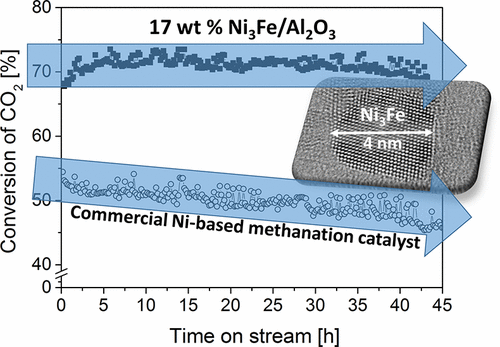当前位置:
X-MOL 学术
›
ACS Catal.
›
论文详情
Our official English website, www.x-mol.net, welcomes your
feedback! (Note: you will need to create a separate account there.)
Potential of an Alumina-Supported Ni3Fe Catalyst in the Methanation of CO2: Impact of Alloy Formation on Activity and Stability
ACS Catalysis ( IF 11.3 ) Pub Date : 2017-09-11 00:00:00 , DOI: 10.1021/acscatal.7b01896 Benjamin Mutz 1 , Michael Belimov , Wu Wang , Paul Sprenger 1 , Marc-André Serrer 1 , Di Wang , Peter Pfeifer , Wolfgang Kleist 1 , Jan-Dierk Grunwaldt 1
ACS Catalysis ( IF 11.3 ) Pub Date : 2017-09-11 00:00:00 , DOI: 10.1021/acscatal.7b01896 Benjamin Mutz 1 , Michael Belimov , Wu Wang , Paul Sprenger 1 , Marc-André Serrer 1 , Di Wang , Peter Pfeifer , Wolfgang Kleist 1 , Jan-Dierk Grunwaldt 1
Affiliation

|
A promising bimetallic 17 wt % Ni3Fe catalyst supported on γ-Al2O3 was prepared via homogeneous deposition–precipitation for the application in the methanation of CO2 to gather more detailed insight into the structure and performance of the catalyst compared to state-of-the-art methanation systems. X-ray diffraction (XRD) analysis, detailed investigations using scanning transmission electron microscopy (STEM) combined with energy dispersive X-ray spectroscopy analysis (EDX) of single particles as well as larger areas, high-resolution transmission electron microscopy (HRTEM) imaging, temperature-programmed reduction (H2-TPR), and in-depth interpretation of Raman bands led to the conclusion that a high fraction of the Ni and Fe formed the desired Ni3Fe alloy resulting in small and well-defined nanoparticles with 4 nm in size and a dispersion of 24%. For comparison, a monometallic catalyst with similar dispersion using the same preparation method and analysis was prepared. Using a fixed-bed reactor, the Ni3Fe catalyst showed better low-temperature performance compared to a monometallic Ni reference catalyst, especially at elevated pressures. Long-term experiments in a microchannel packed bed reactor under industrially relevant reaction conditions in competition with a commercial Ni-based methanation catalyst revealed an improved performance of the Ni3Fe system at 358 °C and 6 bar involving enhanced conversion of CO2 to 71%, selectivity to CH4 > 98%, and most notably a high stability. Deactivation occurred only at lower temperatures, which was related to carbon deposition due to an increased CO production. Kinetic measurements were compared with literature models derived for Ni/Al2O3 catalysts, which fit well but underestimate the performance of the Ni3Fe system, emphasizing the synergetic effect of Ni and Fe.
中文翻译:

氧化铝负载的Ni 3 Fe催化剂在CO 2甲烷化中的潜力:合金形成对活性和稳定性的影响
一个有前途的双金属17重量%的Ni 3支撑在Fe催化剂的γ-Al 2 ö 3经由均匀沉积-沉淀制备中的CO甲烷化的应用2至收集更详细的洞察的结构和催化剂的性能相比状态最先进的甲烷化系统。X射线衍射(XRD)分析,使用扫描透射电子显微镜(STEM)结合单个颗粒的能量色散X射线光谱分析(EDX)以及较大面积的详细研究,高分辨率透射电子显微镜(HRTEM)成像,程序升温还原(H 2-TPR)和拉曼能带的深入解释得出这样的结论,即高含量的Ni和Fe形成了所需的Ni 3 Fe合金,从而产生了尺寸为4 nm,分散度为24 nm的细小且轮廓分明的纳米颗粒%。为了进行比较,使用相同的制备方法和分析方法制备了具有相似分散度的单金属催化剂。与单金属Ni参比催化剂相比,使用固定床反应器,Ni 3 Fe催化剂表现出更好的低温性能,尤其是在升高的压力下。在微通道填充床反应器中与工业上基于镍的甲烷化催化剂竞争的工业相关反应条件下的长期实验表明,Ni 3的性能有所提高Fe体系在358°C和6 bar的压力下,CO 2转化为71%的转化率提高,对CH 4的选择性> 98%,并且稳定性最高。失活仅在较低的温度下发生,这与由于增加的CO产生而导致的碳沉积有关。将动力学测量结果与针对Ni / Al 2 O 3催化剂得出的文献模型进行了比较,该模型很好,但低估了Ni 3 Fe体系的性能,强调了Ni和Fe的协同作用。
更新日期:2017-09-11
中文翻译:

氧化铝负载的Ni 3 Fe催化剂在CO 2甲烷化中的潜力:合金形成对活性和稳定性的影响
一个有前途的双金属17重量%的Ni 3支撑在Fe催化剂的γ-Al 2 ö 3经由均匀沉积-沉淀制备中的CO甲烷化的应用2至收集更详细的洞察的结构和催化剂的性能相比状态最先进的甲烷化系统。X射线衍射(XRD)分析,使用扫描透射电子显微镜(STEM)结合单个颗粒的能量色散X射线光谱分析(EDX)以及较大面积的详细研究,高分辨率透射电子显微镜(HRTEM)成像,程序升温还原(H 2-TPR)和拉曼能带的深入解释得出这样的结论,即高含量的Ni和Fe形成了所需的Ni 3 Fe合金,从而产生了尺寸为4 nm,分散度为24 nm的细小且轮廓分明的纳米颗粒%。为了进行比较,使用相同的制备方法和分析方法制备了具有相似分散度的单金属催化剂。与单金属Ni参比催化剂相比,使用固定床反应器,Ni 3 Fe催化剂表现出更好的低温性能,尤其是在升高的压力下。在微通道填充床反应器中与工业上基于镍的甲烷化催化剂竞争的工业相关反应条件下的长期实验表明,Ni 3的性能有所提高Fe体系在358°C和6 bar的压力下,CO 2转化为71%的转化率提高,对CH 4的选择性> 98%,并且稳定性最高。失活仅在较低的温度下发生,这与由于增加的CO产生而导致的碳沉积有关。将动力学测量结果与针对Ni / Al 2 O 3催化剂得出的文献模型进行了比较,该模型很好,但低估了Ni 3 Fe体系的性能,强调了Ni和Fe的协同作用。











































 京公网安备 11010802027423号
京公网安备 11010802027423号